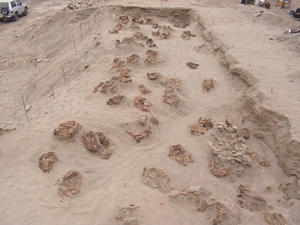Why the Chimú people of ancient Peru offered what was most valuable to them

The largest human and animal sacrifice ever found in Peru was recently uncovered in a small fishing village.
(Courtesy Angiolina Abugattas)
Each year the technology used by archaeologists to locate sites becomes more sophisticated. Satellite images, Google Earth, and ground-penetrating radar are now combined with more traditional methods such as surface surveys and test trenches to determine how and where archaeologists will excavate. But sometimes one of the best sources of information about an area—and one that is frequently overlooked—is the knowledge of the local people who live there and whose families have been there for generations. Such is the case with a site in the small Peruvian coastal town of Huanchaquito that has come to be referred to by the locals as Las Llamas—The Llamas. It is a site that has a great deal to tell about the Andean Chimú culture and their religious and sacrificial practices.
Archaeologist Oscar Gabriel Prieto grew up in the town of Huanchaco, next to Huanchaquito. There, from the time that he was six years old, he would walk around sites in the area. He recently returned to excavate Pampas Gramalote, a small fishing village dating to between 2000 and 1200 B.C. While working there one day in August 2011, Prieto was approached by a resident of Huanchaquito who asked him if he was an archaeologist. When Prieto answered yes, the man said, "Then you have to come with me. Only 300 yards from here, there is another area filled with human bones, including skulls. I know these things are important."

To read more, find ARCHAEOLOGY in your local newsstand or bookstore, or click here to buy a copy of the issue online. And if you'd like to receive ARCHAEOLOGY in your mailbox, click here to subscribe.
Jarrett A. Lobell is executive editor at ARCHAEOLOGY.

